Zhiqi Huang
Kimi K2: Open Agentic Intelligence
Jul 28, 2025Abstract:We introduce Kimi K2, a Mixture-of-Experts (MoE) large language model with 32 billion activated parameters and 1 trillion total parameters. We propose the MuonClip optimizer, which improves upon Muon with a novel QK-clip technique to address training instability while enjoying the advanced token efficiency of Muon. Based on MuonClip, K2 was pre-trained on 15.5 trillion tokens with zero loss spike. During post-training, K2 undergoes a multi-stage post-training process, highlighted by a large-scale agentic data synthesis pipeline and a joint reinforcement learning (RL) stage, where the model improves its capabilities through interactions with real and synthetic environments. Kimi K2 achieves state-of-the-art performance among open-source non-thinking models, with strengths in agentic capabilities. Notably, K2 obtains 66.1 on Tau2-Bench, 76.5 on ACEBench (En), 65.8 on SWE-Bench Verified, and 47.3 on SWE-Bench Multilingual -- surpassing most open and closed-sourced baselines in non-thinking settings. It also exhibits strong capabilities in coding, mathematics, and reasoning tasks, with a score of 53.7 on LiveCodeBench v6, 49.5 on AIME 2025, 75.1 on GPQA-Diamond, and 27.1 on OJBench, all without extended thinking. These results position Kimi K2 as one of the most capable open-source large language models to date, particularly in software engineering and agentic tasks. We release our base and post-trained model checkpoints to facilitate future research and applications of agentic intelligence.
G1: Bootstrapping Perception and Reasoning Abilities of Vision-Language Model via Reinforcement Learning
May 19, 2025Abstract:Vision-Language Models (VLMs) excel in many direct multimodal tasks but struggle to translate this prowess into effective decision-making within interactive, visually rich environments like games. This ``knowing-doing'' gap significantly limits their potential as autonomous agents, as leading VLMs often performing badly in simple games. To address this, we introduce VLM-Gym, a curated reinforcement learning (RL) environment featuring diverse visual games with unified interfaces and adjustable, compositional difficulty, specifically designed for scalable multi-game parallel training. Leveraging VLM-Gym, we train G0 models using pure RL-driven self-evolution, which demonstrate emergent perception and reasoning patterns. To further mitigate challenges arising from game diversity, we develop G1 models. G1 incorporates a perception-enhanced cold start prior to RL fine-tuning. Our resulting G1 models consistently surpass their teacher across all games and outperform leading proprietary models like Claude-3.7-Sonnet-Thinking. Systematic analysis reveals an intriguing finding: perception and reasoning abilities mutually bootstrap each other throughout the RL training process. Source code including VLM-Gym and RL training are released at https://github.com/chenllliang/G1 to foster future research in advancing VLMs as capable interactive agents.
Kimi-VL Technical Report
Apr 10, 2025

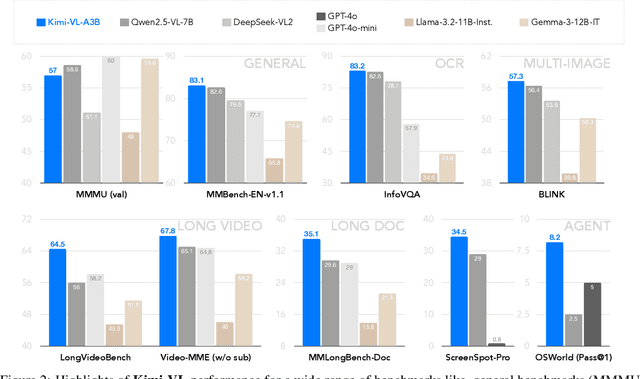

Abstract:We present Kimi-VL, an efficient open-source Mixture-of-Experts (MoE) vision-language model (VLM) that offers advanced multimodal reasoning, long-context understanding, and strong agent capabilities - all while activating only 2.8B parameters in its language decoder (Kimi-VL-A3B). Kimi-VL demonstrates strong performance across challenging domains: as a general-purpose VLM, Kimi-VL excels in multi-turn agent tasks (e.g., OSWorld), matching flagship models. Furthermore, it exhibits remarkable capabilities across diverse challenging vision language tasks, including college-level image and video comprehension, OCR, mathematical reasoning, and multi-image understanding. In comparative evaluations, it effectively competes with cutting-edge efficient VLMs such as GPT-4o-mini, Qwen2.5-VL-7B, and Gemma-3-12B-IT, while surpassing GPT-4o in several key domains. Kimi-VL also advances in processing long contexts and perceiving clearly. With a 128K extended context window, Kimi-VL can process diverse long inputs, achieving impressive scores of 64.5 on LongVideoBench and 35.1 on MMLongBench-Doc. Its native-resolution vision encoder, MoonViT, further allows it to see and understand ultra-high-resolution visual inputs, achieving 83.2 on InfoVQA and 34.5 on ScreenSpot-Pro, while maintaining lower computational cost for common tasks. Building upon Kimi-VL, we introduce an advanced long-thinking variant: Kimi-VL-Thinking. Developed through long chain-of-thought (CoT) supervised fine-tuning (SFT) and reinforcement learning (RL), this model exhibits strong long-horizon reasoning capabilities. It achieves scores of 61.7 on MMMU, 36.8 on MathVision, and 71.3 on MathVista while maintaining the compact 2.8B activated LLM parameters, setting a new standard for efficient multimodal thinking models. Code and models are publicly accessible at https://github.com/MoonshotAI/Kimi-VL.
Efficient Inference for Large Reasoning Models: A Survey
Mar 29, 2025
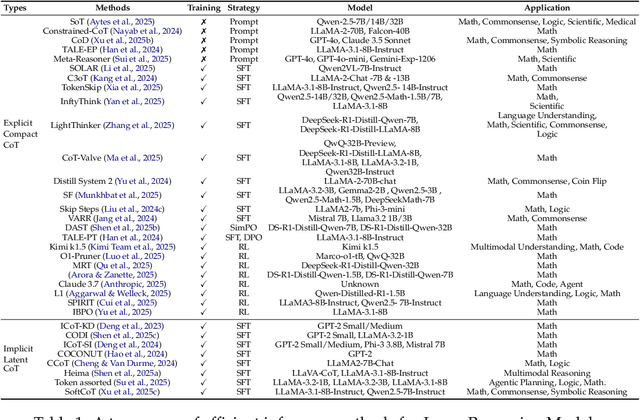
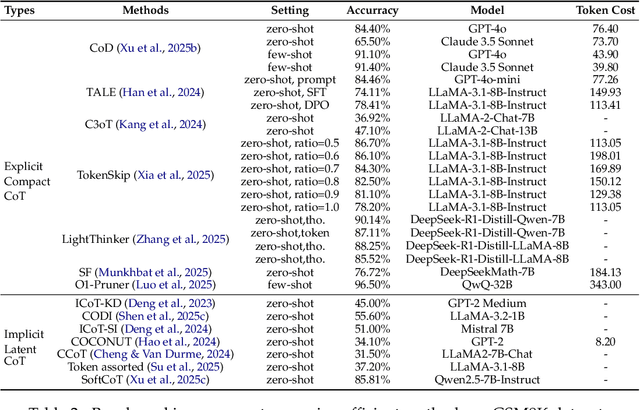
Abstract:Large Reasoning Models (LRMs) significantly improve the reasoning ability of Large Language Models (LLMs) by learning to reason, exhibiting promising performance in complex task-solving. However, their deliberative reasoning process leads to inefficiencies in token usage, memory consumption, and inference time. Thus, this survey provides a review of efficient inference methods designed specifically for LRMs, focusing on mitigating token inefficiency while preserving the reasoning quality. First, we introduce a taxonomy to group the recent methods into two main categories: (a) explicit compact Chain-of-Thought (CoT), which reduces tokens while keeping the explicit reasoning structure, and (b) implicit latent CoT, which encodes reasoning steps within hidden representations instead of explicit tokens. Meanwhile, we discuss their strengths and weaknesses. Then, we conduct empirical analyses on existing methods from performance and efficiency aspects. Besides, we present open challenges in this field, including human-centric controllable reasoning, trade-off between interpretability and efficiency of reasoning, ensuring safety of efficient reasoning, and broader applications of efficient reasoning. In addition, we highlight key insights for enhancing LRMs' inference efficiency via techniques such as model merging, new architectures, and agent routers. We hope this work serves as a valuable guide, helping researchers overcome challenges in this vibrant field\footnote{https://github.com/yueliu1999/Awesome-Efficient-Inference-for-LRMs}.
A Survey of Model Architectures in Information Retrieval
Feb 20, 2025Abstract:This survey examines the evolution of model architectures in information retrieval (IR), focusing on two key aspects: backbone models for feature extraction and end-to-end system architectures for relevance estimation. The review intentionally separates architectural considerations from training methodologies to provide a focused analysis of structural innovations in IR systems.We trace the development from traditional term-based methods to modern neural approaches, particularly highlighting the impact of transformer-based models and subsequent large language models (LLMs). We conclude by discussing emerging challenges and future directions, including architectural optimizations for performance and scalability, handling of multimodal, multilingual data, and adaptation to novel application domains beyond traditional search paradigms.
MoBA: Mixture of Block Attention for Long-Context LLMs
Feb 18, 2025



Abstract:Scaling the effective context length is essential for advancing large language models (LLMs) toward artificial general intelligence (AGI). However, the quadratic increase in computational complexity inherent in traditional attention mechanisms presents a prohibitive overhead. Existing approaches either impose strongly biased structures, such as sink or window attention which are task-specific, or radically modify the attention mechanism into linear approximations, whose performance in complex reasoning tasks remains inadequately explored. In this work, we propose a solution that adheres to the ``less structure'' principle, allowing the model to determine where to attend autonomously, rather than introducing predefined biases. We introduce Mixture of Block Attention (MoBA), an innovative approach that applies the principles of Mixture of Experts (MoE) to the attention mechanism. This novel architecture demonstrates superior performance on long-context tasks while offering a key advantage: the ability to seamlessly transition between full and sparse attention, enhancing efficiency without the risk of compromising performance. MoBA has already been deployed to support Kimi's long-context requests and demonstrates significant advancements in efficient attention computation for LLMs. Our code is available at https://github.com/MoonshotAI/MoBA.
Rhythmic Foley: A Framework For Seamless Audio-Visual Alignment In Video-to-Audio Synthesis
Sep 13, 2024



Abstract:Our research introduces an innovative framework for video-to-audio synthesis, which solves the problems of audio-video desynchronization and semantic loss in the audio. By incorporating a semantic alignment adapter and a temporal synchronization adapter, our method significantly improves semantic integrity and the precision of beat point synchronization, particularly in fast-paced action sequences. Utilizing a contrastive audio-visual pre-trained encoder, our model is trained with video and high-quality audio data, improving the quality of the generated audio. This dual-adapter approach empowers users with enhanced control over audio semantics and beat effects, allowing the adjustment of the controller to achieve better results. Extensive experiments substantiate the effectiveness of our framework in achieving seamless audio-visual alignment.
FD2Talk: Towards Generalized Talking Head Generation with Facial Decoupled Diffusion Model
Aug 18, 2024Abstract:Talking head generation is a significant research topic that still faces numerous challenges. Previous works often adopt generative adversarial networks or regression models, which are plagued by generation quality and average facial shape problem. Although diffusion models show impressive generative ability, their exploration in talking head generation remains unsatisfactory. This is because they either solely use the diffusion model to obtain an intermediate representation and then employ another pre-trained renderer, or they overlook the feature decoupling of complex facial details, such as expressions, head poses and appearance textures. Therefore, we propose a Facial Decoupled Diffusion model for Talking head generation called FD2Talk, which fully leverages the advantages of diffusion models and decouples the complex facial details through multi-stages. Specifically, we separate facial details into motion and appearance. In the initial phase, we design the Diffusion Transformer to accurately predict motion coefficients from raw audio. These motions are highly decoupled from appearance, making them easier for the network to learn compared to high-dimensional RGB images. Subsequently, in the second phase, we encode the reference image to capture appearance textures. The predicted facial and head motions and encoded appearance then serve as the conditions for the Diffusion UNet, guiding the frame generation. Benefiting from decoupling facial details and fully leveraging diffusion models, extensive experiments substantiate that our approach excels in enhancing image quality and generating more accurate and diverse results compared to previous state-of-the-art methods.
Mask-ControlNet: Higher-Quality Image Generation with An Additional Mask Prompt
Apr 08, 2024Abstract:Text-to-image generation has witnessed great progress, especially with the recent advancements in diffusion models. Since texts cannot provide detailed conditions like object appearance, reference images are usually leveraged for the control of objects in the generated images. However, existing methods still suffer limited accuracy when the relationship between the foreground and background is complicated. To address this issue, we develop a framework termed Mask-ControlNet by introducing an additional mask prompt. Specifically, we first employ large vision models to obtain masks to segment the objects of interest in the reference image. Then, the object images are employed as additional prompts to facilitate the diffusion model to better understand the relationship between foreground and background regions during image generation. Experiments show that the mask prompts enhance the controllability of the diffusion model to maintain higher fidelity to the reference image while achieving better image quality. Comparison with previous text-to-image generation methods demonstrates our method's superior quantitative and qualitative performance on the benchmark datasets.
Are Large Language Models Really Robust to Word-Level Perturbations?
Sep 27, 2023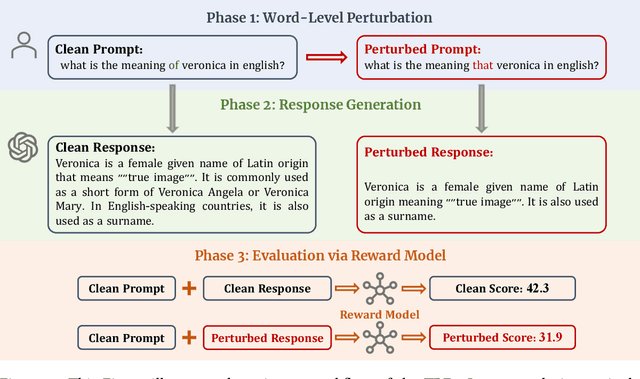

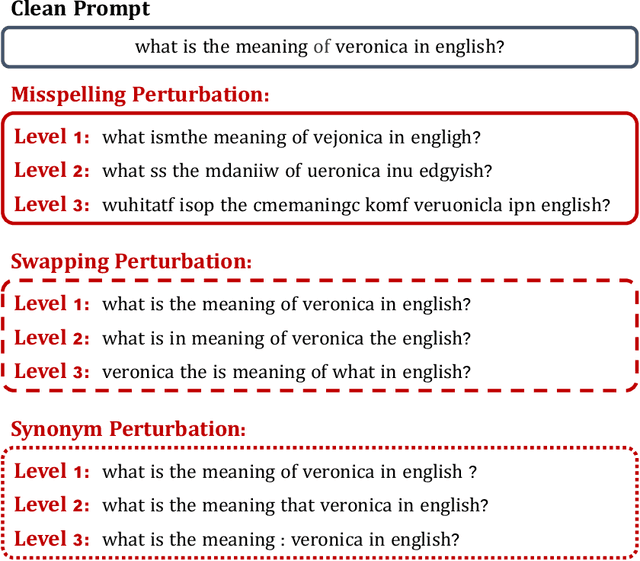

Abstract:The swift advancement in the scales and capabilities of Large Language Models (LLMs) positions them as promising tools for a variety of downstream tasks. In addition to the pursuit of better performance and the avoidance of violent feedback on a certain prompt, to ensure the responsibility of the LLM, much attention is drawn to the robustness of LLMs. However, existing evaluation methods mostly rely on traditional question answering datasets with predefined supervised labels, which do not align with the superior generation capabilities of contemporary LLMs. To address this issue, we propose a novel rational evaluation approach that leverages pre-trained reward models as diagnostic tools to evaluate the longer conversation generated from more challenging open questions by LLMs, which we refer to as the Reward Model for Reasonable Robustness Evaluation (TREvaL). Longer conversations manifest the comprehensive grasp of language models in terms of their proficiency in understanding questions, a capability not entirely encompassed by individual words or letters, which may exhibit oversimplification and inherent biases. Our extensive empirical experiments demonstrate that TREvaL provides an innovative method for evaluating the robustness of an LLM. Furthermore, our results demonstrate that LLMs frequently exhibit vulnerability to word-level perturbations that are commonplace in daily language usage. Notably, we are surprised to discover that robustness tends to decrease as fine-tuning (SFT and RLHF) is conducted. The code of TREval is available in https://github.com/Harry-mic/TREvaL.
 Add to Chrome
Add to Chrome Add to Firefox
Add to Firefox Add to Edge
Add to Edge